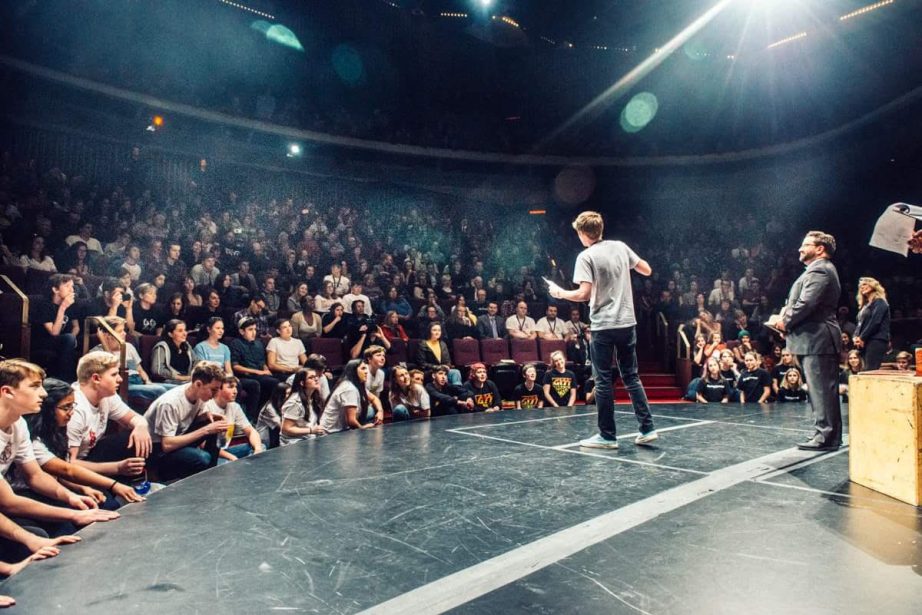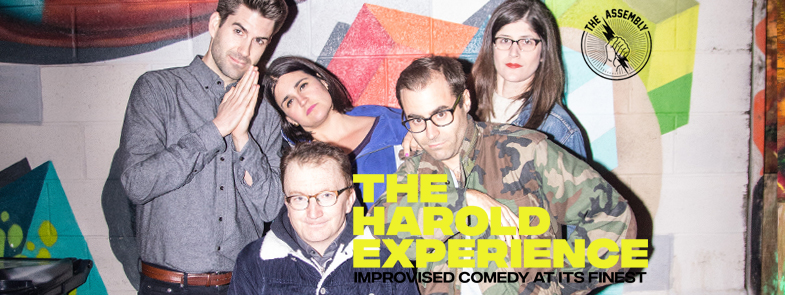Ryan Millar is a Canadian-born improviser, writer, and comedian living in Amsterdam. With almost 20 years’ experience teaching, training, and entertaining, he’s now put all that knowledge and experience in book form.

Photo © Ryan Millar
P&C: How is Take It Easy different from other improv books out there?
RM: I think mostly just because it’s written from my point of view. It’s a personal book, with lots of anecdotes and reflections based on my experience performing and teaching all around Europe and North America. And I tried to write it as I teach, so it maintains that perspective throughout.
Also, Take It Easy isn’t an improv manual. Although I love teaching improv fundamentals to absolute beginners, I had no desire to write a book of improv basics for newbies, or even a book of “rules.”
This was partially because I wanted to speak to the core demographic of improvisers – people who are improvisers already, and love it, but are looking to elevate their game. Why else are they reading a book about it?
The other reason I didn’t write a book for beginners is because that area is so well covered by other texts. There was no need for me to retread an area that’s already so well-served.
P&C: How does your approach apply to different styles of improvisation?
RM: When I say, “Take It Easy isn’t a new way of doing improv, it’s a mindset that can inform your performance and approach to improvisation,” I mean the book is designed to help the individual performer, no matter where they’re at, or what aspect of improv attracts them most.
I guess I was looking to tackle something that I found universal: there’s a core of good improv habits and practice that will make you a better player, whether you’re doing shortform, longform detailed genre shows, fast-and-loose jams, or something else entirely. These core elements were the thing I wanted to focus on.
P&C: Who are your improv heroes, and what’s the most important lesson you learned from them?
Oh man, there are so many people who’ve influenced me in my improv journey. I’ll just mention a couple.
Keith Johnstone taught me a weekend workshop when I’d only been improvising for a few months. And the words “Make sure your partner is having a good time” really resonated with me then, and still do.
Alistair Cook was and is an improv pioneer and good friend. He really pushed both the artistic and organisational bounds of improv in Vancouver when I was coming up. He taught me to always value the work onstage, and build a good atmosphere offstage.
When I first moved to Amsterdam in 2003 (to do a student exchange year), I got a part-time job doing corporate shows with Boom Chicago. I had spent the early part of my improv career being patient, exploratory and nuanced. Now there was no time for that! Scenes had to be fast and funny, no exceptions. I don’t play that way all the time, but doing speed reps in their sharp performative house style has been a big influence on how I continued to develop and play (even if it is quite contrary to the ideas in Take It Easy).
P&C: Take It Easy is for teachers, as well as students. What are some of the things you’ve learned through training others?
RM: Being a great improviser doesn’t necessarily mean you’ll be a great teacher, and you don’t necessarily need to be an incredible performer to be a great teacher.
But what I’ve really noticed from teaching – which is why I started writing this book in the first place – is that a lot of students and performers were really trying hard. It makes sense: they love improv and want to get better, so they put in a lot of hours and effort. But that very impulse to work hard was getting in the way of their success.
Just before finalizing the book I found this great Bruce Lee quote: “The less effort, the faster and more powerful you will be.” When I read that I was like “Yes! This is what the book is about!”
Of course, the truth is more complex than that, but the essence of the quote – that only by trying less (by “taking it easy,” if you will), can you truly excel. That paradox becomes especially interesting when trying to teach.
Some things I learned through training others:
- Take nothing for granted. Things that a more experienced improviser may think are obvious or facile can still blow a newbie’s mind.
- Never stop taking workshops. There’s always more to learn.
- Improv can be transformative. Enjoy helping people find those Aha! Moments.
- Commitment is everything. If you don’t put yourself into the work, you won’t get much out of it.
P&C: Improv is such a group-oriented art form, but it’s also fun to do on your own, even if you never perform solo. You’ve included solo games and exercises in Take It Easy. Could you give us an example?
RM: I have a series of exercises in the book, that I think partially come out of the Canadian Improv Games handbook. One I really like, that is actually a series of connected excercises, is What it is.
In What it is, the participants roam the room pointing at objects (not people), confidently (and loudly) proclaiming what they are: “chair,” “water bottle,” “notebook,” “backpack,” “door,” etc.
The goal is to move quickly, observe lots, and be confident in your words.
I use this in other workshops I teach (such as Public Speaking), but I developed a later round of What it is, called What it is, specifically, which I think really gets at the heart of how to Take It Easy. In this version, you point at things and, rather than just shouting out what they are, you actually describe them, and find inspiration in what you see.
So it might go something like this:
“A theatre seat with a ripped corner, a three-quarters empty water bottle with a peeling label, a pair of New Balance sneakers that have spent a lot of time in the mud…” and so on.
Another related version is called What it is like, and can even involve more interpretation, speculation, simile and other forms of freedom to depart from what is actually seen.
So this round could go something like:
“A theatre seat that has a corner ripped out from the great CATS riot of 1987, a water bottle containing about 80 ml of the precious liquid so prized in this post-apocalyptic world, New Balance sneakers worn by a dedicated ultra marathon runner, before their knee injury…” and so on.
What happens in both What it is specifically and What it is like is that people realise checking stuff off a list isn’t nearly as rewarding as paying attention to what’s there in front of them, and then pushing their imagination to be fired off objects that might seem mundane. Using what you have to create a rich detailed world is classic Take It Easy.
I frequently play some combination of these when warming up for a solo set.
P&C: You blew past your Indiegogo goal for the first print run. Congrats! Will there be more soon?
RM: Thank you! The response to the crowdfunding campaign absolutely blew me away! I’d been planning crowdfunding for this book for a long time (years, even). I spent some of that time doing a lot of preparation and reading, and that certainly seemed to pay off.
Also, a lot of my support came from people who aren’t improvisers. Friends and family and even extended network and strangers, all of whom I presume are both supportive and will be interested in reading what I wrote, even if they’re not improvisers. I think there will be enough in this book to keep them reading. I sure hope so.
I’m not sure about doing more crowdfunding campaigns, but I’ve got a few more ideas for books (and some of those are further along than the idea stage).
So once I get this book printed and sent out to the backers, and listed on Amazon (and learn all the lessons about independent publishing that I’m currently learning), I think there will be more books.
So, short answer: Yes!
For more info, check out www.takeiteasy.tips.











